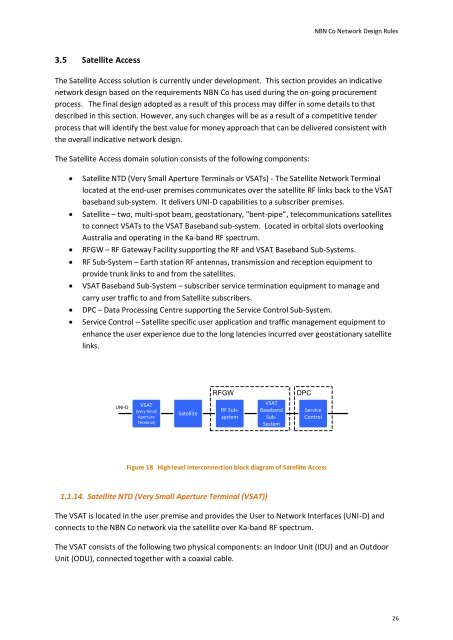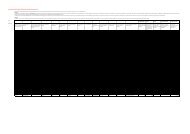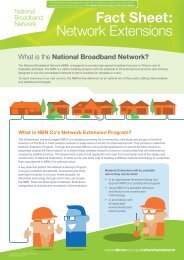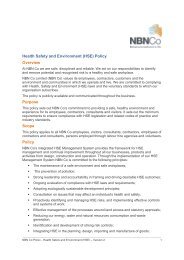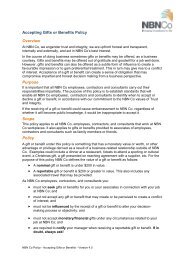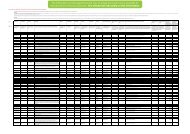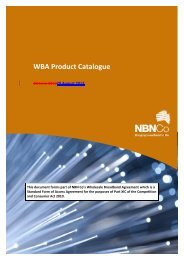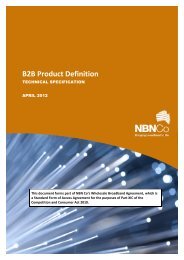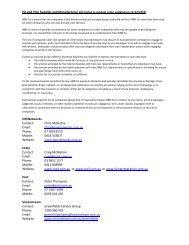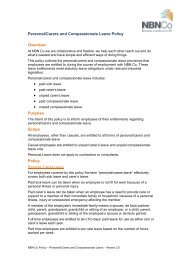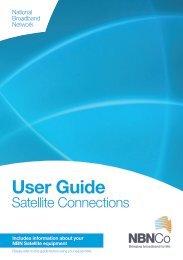NBN Co Network Design Rules
NBN Co Network Design Rules
NBN Co Network Design Rules
You also want an ePaper? Increase the reach of your titles
YUMPU automatically turns print PDFs into web optimized ePapers that Google loves.
<strong>NBN</strong> <strong>Co</strong> <strong>Network</strong> <strong>Design</strong> <strong>Rules</strong><br />
3.5 Satellite Access<br />
The Satellite Access solution is currently under development. This section provides an indicative<br />
network design based on the requirements <strong>NBN</strong> <strong>Co</strong> has used during the on-going procurement<br />
process. The final design adopted as a result of this process may differ in some details to that<br />
described in this section. However, any such changes will be as a result of a competitive tender<br />
process that will identify the best value for money approach that can be delivered consistent with<br />
the overall indicative network design.<br />
The Satellite Access domain solution consists of the following components:<br />
<br />
<br />
<br />
<br />
<br />
<br />
<br />
Satellite NTD (Very Small Aperture Terminals or VSATs) - The Satellite <strong>Network</strong> Terminal<br />
located at the end-user premises communicates over the satellite RF links back to the VSAT<br />
baseband sub-system. It delivers UNI-D capabilities to a subscriber premises.<br />
Satellite – two, multi-spot beam, geostationary, "bent-pipe”, telecommunications satellites<br />
to connect VSATs to the VSAT Baseband sub-system. Located in orbital slots overlooking<br />
Australia and operating in the Ka-band RF spectrum.<br />
RFGW – RF Gateway Facility supporting the RF and VSAT Baseband Sub-Systems.<br />
RF Sub-System – Earth station RF antennas, transmission and reception equipment to<br />
provide trunk links to and from the satellites.<br />
VSAT Baseband Sub-System – subscriber service termination equipment to manage and<br />
carry user traffic to and from Satellite subscribers.<br />
DPC – Data Processing Centre supporting the Service <strong>Co</strong>ntrol Sub-System.<br />
Service <strong>Co</strong>ntrol – Satellite specific user application and traffic management equipment to<br />
enhance the user experience due to the long latencies incurred over geostationary satellite<br />
links.<br />
RFGW<br />
DPC<br />
UNI-D<br />
VSAT<br />
(Very Small<br />
Aperture<br />
Terminal)<br />
Satellite<br />
RF Subsystem<br />
VSAT<br />
Baseband<br />
Sub-<br />
System<br />
Service<br />
<strong>Co</strong>ntrol<br />
Figure 18 High level interconnection block diagram of Satellite Access<br />
1.1.14. Satellite NTD (Very Small Aperture Terminal (VSAT))<br />
The VSAT is located in the user premise and provides the User to <strong>Network</strong> Interfaces (UNI-D) and<br />
connects to the <strong>NBN</strong> <strong>Co</strong> network via the satellite over Ka-band RF spectrum.<br />
The VSAT consists of the following two physical components: an Indoor Unit (IDU) and an Outdoor<br />
Unit (ODU), connected together with a coaxial cable.<br />
26


